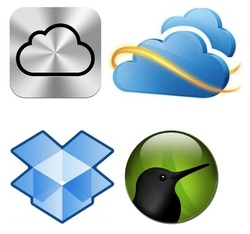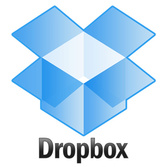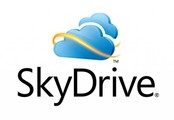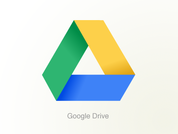







 We are always looking for the bigger, better thing and when it comes to computer files, bigger tends to be the key word. With many files now moving into or past the gigabyte size range, storage for these large items can be difficult to arrange, especially if you have multiple devices. Emailing documents to yourself can be time consuming and tedious, especially with more than one or two devices. Cloud servers have become more and more popular and this includes the ability to synchronize your files from a central location across multiple systems. We will take a look at some of the services that are available for sharing your documents with yourself and others. Cloud servers are storage units provided by a third party in a location other than on your system. This means that if something happens to your device, your data will still be safe and sound on the cloud server. Most of the larger providers also back-up their stored information, so even if something happens to one of their systems, there's another back-up at a different facility with your information. They run highly secure servers and advanced encryption which keeps your data as safe as possible. The type of cloud system we are looking at today is termed "storage as a service" which is exactly that: a service for storing your data.  The first service we are going to look at is Dropbox. This is a very popular file sharing platform which means there is a lot of support and customer feedback out there. Their free plan is 2 GB with no limits on file sizes, daily bandwidth or the number of devices you can use. They also offer referral bonuses of 500 MB per qualifying referral to a maximum of 18 GB. They have paid services starting at $9.99 per month (or $99.99 per year) for 100 GB and increasing from there. One of the nice things that Dropbox offers is a feature called Packrat. Most services will back up your data, keeping prior versions of your files for up to 30 days as part of the basic service. Dropbox does this as well, but with Packrat, you can keep these prior versions as long as you keep Packrat active. This means you can revert a file to a version you last changed six months ago. A very convenient feature that, while it might not be for everyone, is definitely a nice option to have. It has an annual fee of $39.00. Dropbox, fittingly, has a single drop box that is synchronized across your platforms and you simply drag and drop the files you want into the box and they synch automatically onto your other systems with Dropbox installed. You can also edit files online and share your files with others. They offer cross platform support (meaning you can transfer files between Macs and PCs). It also offers mobile support so you can access your data from your mobile devices. When your files update, only the parts that have changed are sent, which means less bandwidth usage.  The next service is CX. CX boasts the largest base storage of any of the free options at 10 GB of space (plus 300 MB additional for each referral to a maximum of an additional 6 GB). It limits you to 2 groups with 2 users per group and a 200 MB group size. A group is simply the number of people that have access to a set of files which means you can share with one other person two sets of files of up to 200 MB. Paid accounts start at $4.99 per month for 25 GB, 2 groups with two users per group and 1 GB group sizes. Their mobile apps are very highly rated and they have online sharing. The one feature that most of their competitors are missing is the ability for file owners and collaborators to actually comment on the file. This helps when working on a collaborative project as you can leave more information that simply what is in that document.  SugarSync is a service that receives a lot of attention from reviewers and for good reason. Their free plan includes 5 GB with no limits and referral bonuses of 500 MB up to a maximum of 32 GB. They are the only one to boast streaming of audio files to your mobile devices which means you can save a lot of space on your smart phone by streaming your music. It has great mobile support and is a fully featured suite that is easy to use and is cross platform. It boasts all of the features of its competitors with improved mobile features. Their paid accounts start at $4.99 per month ($49.99 per year) for 30 GB and goes from there.  Syncplicity has a downside in that many of its accounts limit the number of devices and the number of users you can have. With more devices being able to share files, this can be an issue, especially since most of the competitors don't limit the number of devices used. Their free plan offers 2 GB storage, 1 user and 2 devices but no file size limits. They offer mobile support, auto backup and online sharing. Their paid plans start at $15.00 per month for 50 GB, 1 user and 5 devices with unlimited space and devices available at high price points.  Even the big companies are getting in on cloud offerings. Microsoft and Google both have online storage as does Apple. Apple is offering its iCloud service which integrates with your iPad, iPhone, iPod and Macs not to mention PCs. It works with iTunes and will backup your purchased music automatically and download it to all your iTunes enabled devices. This may seem like your 5 GB won't go very far with all your music purchases being backed up but your music doesn't count towards your capacity. You bought 4 GB worth of music? No problem, you still have your 5 GB of space on the iCloud. If you do end up needing more space, you can get an additional 10 GB for $20 per year or as much as 100 GB for $50 per year, which is a very competitive rate. It also will sync many of your devices and apps, especially those running Apple operating systems, automatically making this a very convenient feature. The sharing is limited but still a very strong, free offering. It also fully integrates with your @me email account.  Microsoft is actually offering more free space than either of the other big two at 7 GB on Skydrive. Previously, Skydrive was 25 GB but they have cut that back, which isn't a big loss as most people won't make use of 7 GB, never mind 25 GB. Again, Microsoft does allow you to buy more storage if you choose with 20 GB for $10 per year, 50 GB for $25 per year and 100 GB for $50 per year. Skydrive works with Hotmail so that you can link to larger files instead of having to send them as attachments, improving email handling. You can also send out one link to a photo gallery, for example, to multiple people at different times, without having to do more than insert a link into your email. You can open and use MS Office documents online and share those documents with other people.  Finally, Google offers Google Drive. They give you 5 GB and this is where all of your Google Documents are stored. The wonderful thing is that your Google documents do not count towards your storage limits, much like purchased content doesn't count against iCloud's limits either. All of your photos are stored in Google+ and can be integrated with Gmail but any photos on Google+ do count towards your 5 GB limit. Google offers expanded storage ranging from 25 GB for $2.49 per month to $799.99 per month for 16 TB of space and many, many options in between. One thing to note is that Gmail typically has a separate 10 GB limit but when you increase your Google drive storage, that limit is increased automatically to 25 GB. With so many options out there, you really do have your choice of providers. Whether you want to go with a popular option like DropBox, a full featured offering like SugarSync or something that will integrate easily with your current devices like iCloud, you can find something to fit your needs without breaking the bank. The paid cloud storage services won't get you the same amount of space you would get if you spent the same amount on a new hard drive, but they're accessible essentially anywhere at any time on almost any device, giving them a definite leg up in that aspect. If you aren't sure what you want, give the free options a try. They may be all you need.
2 Comments
6/9/2013 02:54:08 pm
Thanks a lot pertaining to creating and also sharing this post. We will take a look at some of the services that are available for sharing your documents with yourself and others. I have discovered this for being fascinating and also wise looking at. Beneficial employment.
Reply
9/27/2013 04:48:51 pm
If you want to improve your knowledge only keep visiting this website and be updated with the most recent news update posted here.We are always looking for the bigger, better thing and when it comes to computer files, bigger tends to be the key word. thanks
Reply
Leave a Reply. |
Tell Us What You Want to See!
|
